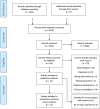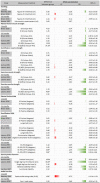Exercise-based rehabilitation reduces reinjury following acute lateral ankle sprain: A systematic review update with meta-analysis
- PMID: 35134061
- PMCID: PMC8824326
- DOI: 10.1371/journal.pone.0262023
Exercise-based rehabilitation reduces reinjury following acute lateral ankle sprain: A systematic review update with meta-analysis
Abstract
Research questions: 1) Do exercise-based rehabilitation programs reduce re-injury following acute ankle sprain?; 2) Is rehabilitation effectiveness moderated by the exercise's therapeutic quality, content and volume?
Methods: This systematic review with meta-analysis (PROSPERO: CRD42020210858) included randomized controlled trials in which adults who sustained an acute ankle sprain received exercise-based rehabilitation as an intervention. Databases CINAHL, Web of Science, SPORTDiscus, Cochrane Central Register of Controlled Trials, PEDro and Google Scholar were searched for eligible articles (last search: March 2021). ROB II screening tool by Cochrane was used to assess risk of bias and the i-CONTENT tool was used to assess quality of interventions. Both qualitative analysis and quantitative data synthesis were performed.
Results: Fourteen randomized controlled trials comprising 2182 participants were included. Five studies were judged overall low risk of bias and i-CONTENT assessment showed poor to moderate therapeutic quality of exercise across all included articles. Pooled data found significant reductions in re-injury prevalence at 12 months, in favour of the exercise-based rehabilitation group vs usual care (OR: 0.60; 95%CI: 0.36 to 0.99). Pooled data for re-injury incidence showed not-significant results (MD: 0.027; 95%CI: -2.14 to 2.19). Meta-regression displayed no statistically significant association between training volume and odds of re-injury (r = -0.00086; SD: 0.00057; 95%CI: -0.00197 to 0.00025). Results from patient-reported outcomes and clinical outcomes were inconclusive at 1 month, 3-6 months and 7-12 months of follow up.
Conclusion: Exercise-based rehabilitation reduces the risk of recurrent ankle sprain compared to usual care, but there is insufficient data to determine the optimal content of exercise-based interventions. Training volume varied considerably across studies but did not affect the odds of sustaining a re-injury. Effects on patient-reported outcomes and clinical outcomes are equivocal. Future research should compare different exercise contents, training volumes and intensities after ankle sprain.
Conflict of interest statement
The authors have declared that no competing interests exist.
Figures








Similar articles
-
Rehabilitation Exercises Reduce Reinjury Post Ankle Sprain, But the Content and Parameters of an Optimal Exercise Program Have Yet to Be Established: A Systematic Review and Meta-analysis.Arch Phys Med Rehabil. 2019 Jul;100(7):1367-1375. doi: 10.1016/j.apmr.2018.10.005. Epub 2018 Oct 26. Arch Phys Med Rehabil. 2019. PMID: 30612980
-
Rehabilitation strategies for lateral ankle sprain do not reflect established mechanisms of re-injury: A systematic review.Phys Ther Sport. 2023 Mar;60:75-83. doi: 10.1016/j.ptsp.2023.01.008. Epub 2023 Jan 23. Phys Ther Sport. 2023. PMID: 36716507
-
The effect of movement representation techniques on ankle function and performance in persons with or without a lateral ankle sprain: a systematic review and meta-analysis.BMC Musculoskelet Disord. 2023 Oct 4;24(1):786. doi: 10.1186/s12891-023-06906-9. BMC Musculoskelet Disord. 2023. PMID: 37794344 Free PMC article.
-
Effectiveness of Conservative Interventions After Acute Hamstrings Injuries in Athletes: A Living Systematic Review.Sports Med. 2023 Mar;53(3):615-635. doi: 10.1007/s40279-022-01783-z. Epub 2023 Jan 9. Sports Med. 2023. PMID: 36622557
-
Effects of balance training on post-sprained ankle joint instability.Int J Risk Saf Med. 2015;27 Suppl 1:S99-S101. doi: 10.3233/JRS-150707. Int J Risk Saf Med. 2015. PMID: 26639734
Cited by
-
Effectiveness of exercise therapy on chronic ankle instability: a meta-analysis.Sci Rep. 2025 Apr 5;15(1):11709. doi: 10.1038/s41598-025-95896-w. Sci Rep. 2025. PMID: 40188228 Free PMC article.
-
Effect of light walking combined with arthroscopic surgery on bone mineral density in patients with foot and ankle osteoarthritis.Heliyon. 2024 Aug 2;10(16):e35575. doi: 10.1016/j.heliyon.2024.e35575. eCollection 2024 Aug 30. Heliyon. 2024. PMID: 39220949 Free PMC article.
-
Heel kicking exercise rapidly improves pain and function in patients with acute lateral ankle sprain: a randomized controlled trial.BMC Musculoskelet Disord. 2025 Jul 8;26(1):666. doi: 10.1186/s12891-025-08881-9. BMC Musculoskelet Disord. 2025. PMID: 40629319 Free PMC article. Clinical Trial.
References
-
- Gribble PA, Bleakley CM, Caulfield BM, Docherty CL, Fourchet F, Fong DT, et al.. Evidence review for the 2016 International Ankle Consortium consensus statement on the prevalence, impact and long-term consequences of lateral ankle sprains. British journal of sports medicine. 2016;50(24):1496–505. doi: 10.1136/bjsports-2016-096189 - DOI - PubMed

